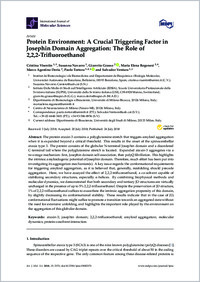Protein environment : a crucial triggering factor in Josephin domain aggregation : the role of 2,2,2-trifluoroethanol
- Visentin, Cristina Institut de Biotecnologia i de Biomedicina and Departament de Bioquímica i Biologia Molecular, Universitat Autònoma de Barcelona, Bellaterra, 08193 Barcelona, Spain
- Navarro, Susanna Institut de Biotecnologia i de Biomedicina and Departament de Bioquímica i Biologia Molecular, Universitat Autònoma de Barcelona, Bellaterra, 08193 Barcelona, Spain
- Grasso, Gianvito Istituto Dalle Molle di studi sull'intelligenza artificiale (IDSIA), Facoltà di scienze informatiche, Università della Svizzera italiana, Svizzera
- Regonesi, Maria Elena Dipartimento di Biotecnologie e Bioscienze, Università di Milano-Bicocca, 20126 Milano, Italy - Centro di Neuroscienze di Milano (Neuro-MI), 20126 Milano, Italy
- Deriu, Marco Agostino Istituto Dalle Molle di studi sull'intelligenza artificiale (IDSIA), Facoltà di scienze informatiche, Università della Svizzera italiana, Svizzera
- Tortora, Paolo Dipartimento di Biotecnologie e Bioscienze, Università di Milano-Bicocca, 20126 Milano, Italy - Centro di Neuroscienze di Milano (Neuro-MI), 20126 Milano, Italy
- Ventura, Salvador Institut de Biotecnologia i de Biomedicina and Departament de Bioquímica i Biologia Molecular, Universitat Autònoma de Barcelona, Bellaterra, 08193 Barcelona, Spain
-
24.07.2018
Published in:
- International journal of molecular sciences. - 2018, vol. 19, no. 8, p. 2151
Ataxin-3
Josephin domain
2,2,2-trifluoroethanol
Amyloid aggregation
Molecular dynamics
Protein-cosolvent interaction
English
The protein ataxin-3 contains a polyglutamine stretch that triggers amyloid aggregation when it is expanded beyond a critical threshold. This results in the onset of the spinocerebellar ataxia type 3. The protein consists of the globular N-terminal Josephin domain and a disordered C-terminal tail where the polyglutamine stretch is located. Expanded ataxin-3 aggregates via a two-stage mechanism: first, Josephin domain self- association, then polyQ fibrillation. This highlights the intrinsic amyloidogenic potential of Josephin domain. Therefore, much effort has been put into investigating its aggregation mechanism(s). A key issue regards the conformational requirements for triggering amyloid aggregation, as it is believed that, generally, misfolding should precede aggregation. Here, we have assayed the effect of 2,2,2-trifluoroethanol, a co-solvent capable of stabilizing secondary structures, especially α-helices. By combining biophysical methods and molecular dynamics, we demonstrated that both secondary and tertiary JD structures are virtually unchanged in the presence of up to 5% 2,2,2-trifluoroethanol. Despite the preservation of JD structure, 1% of 2,2,2-trifluoroethanol suffices to exacerbate the intrinsic aggregation propensity of this domain, by slightly decreasing its conformational stability. These results indicate that in the case of JD, conformational fluctuations might suffice to promote a transition towards an aggregated state without the need for extensive unfolding, and highlights the important role played by the environment on the aggregation of this globular domain.
- Language
-
- English
- Classification
- Chemistry
- License
- Open access status
- gold
- Identifiers
-
- RERO DOC 328284
- DOI 10.3390/ijms19082151
- ARK ark:/12658/srd1319153
- Persistent URL
- https://n2t.net/ark:/12658/srd1319153
Statistics
Document views: 127
File downloads:
- Texte intégral: 187
